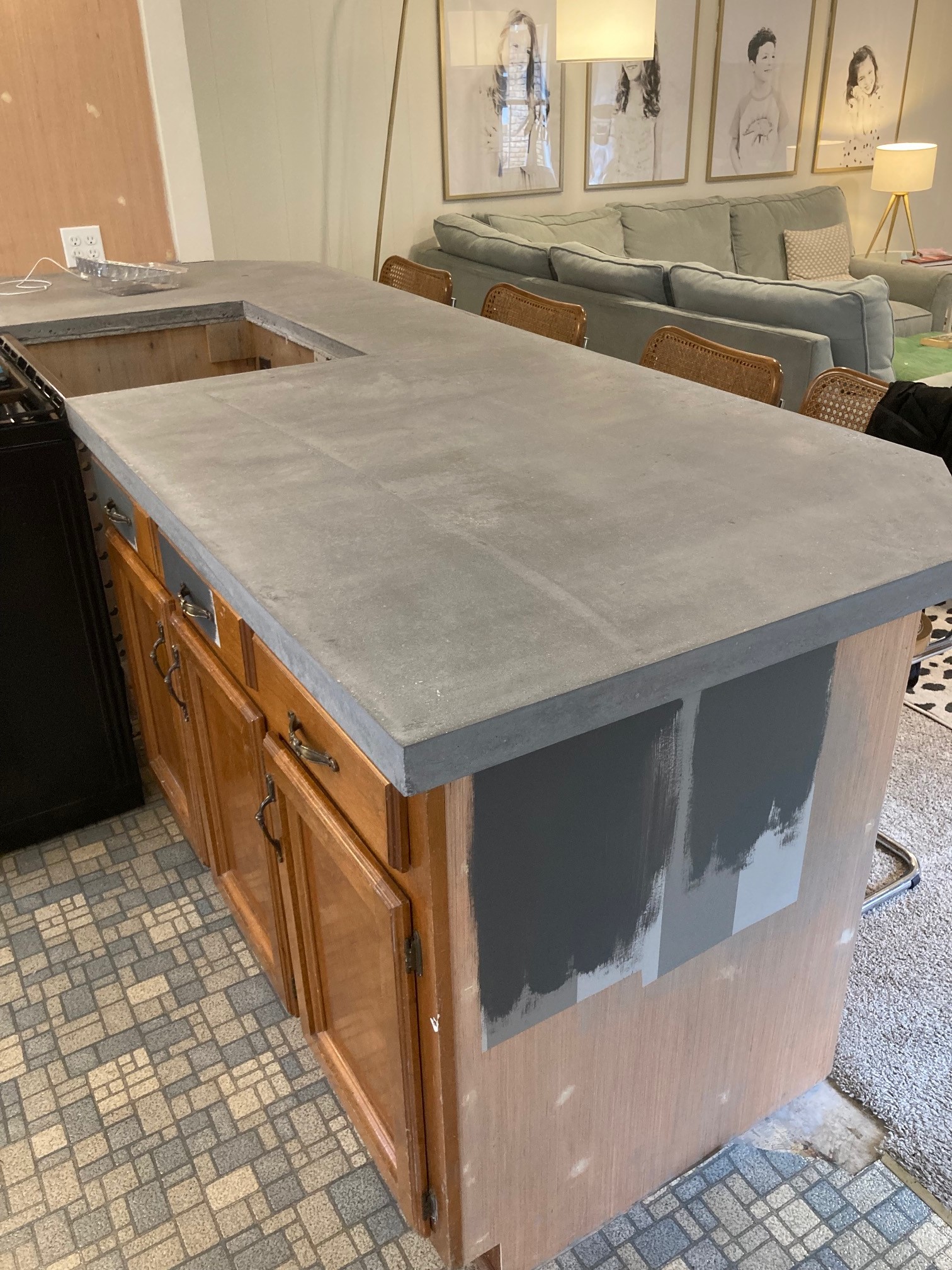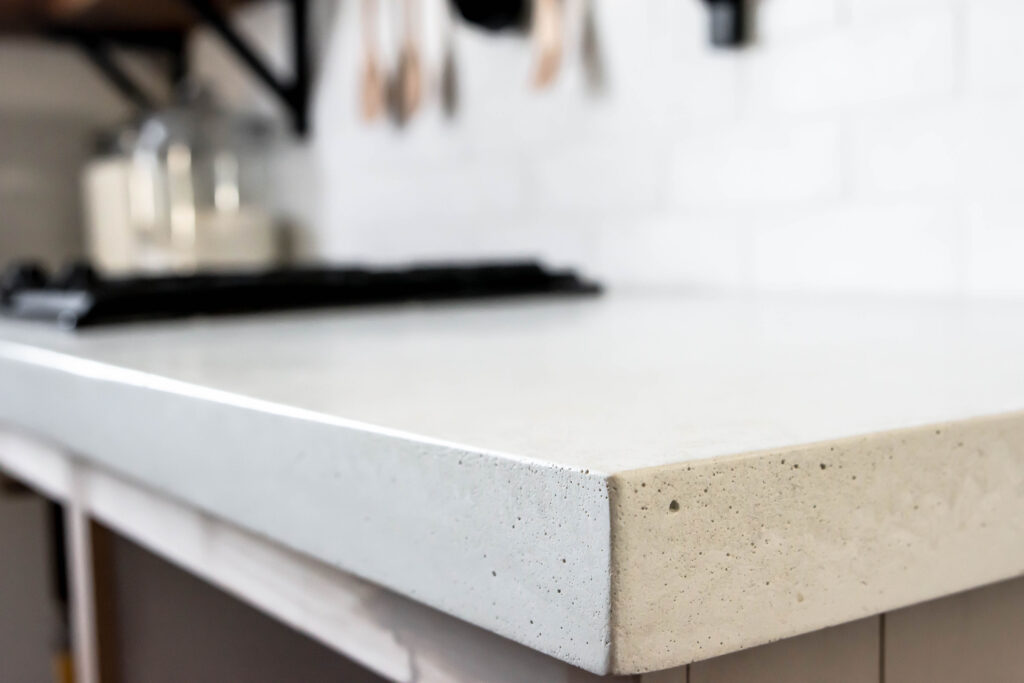Painting concrete countertops is a cost-effective way to refresh the look of your kitchen or bathroom without the need for a full replacement. While concrete countertops are known for their durability and versatility, painting them can offer a quick and budget-friendly update to match your changing style preferences. Here’s a comprehensive guide to painting concrete countertops:
Surface Preparation: Proper surface preparation is crucial for a successful paint job on concrete countertops. Start by thoroughly cleaning the countertops with a degreaser and warm water to remove any dirt, grease, or stains. Use a concrete cleaner or etching solution to roughen the surface and create a better bond for the paint. Rinse the countertops thoroughly and allow them to dry completely before proceeding.
Repair Any Damage: Before painting, inspect the countertops for any cracks, chips, or other damage. Repair any imperfections with a concrete patching compound, following the manufacturer’s instructions. Smooth out the patching compound with a putty knife and allow it to dry completely before sanding the surface smooth.
Priming: Apply a high-quality primer specifically designed for use on concrete surfaces. Use a brush or roller to apply the primer evenly over the entire surface of the countertops, making sure to reach into any seams or crevices. Allow the primer to dry completely according to the manufacturer’s instructions before proceeding to the next step.
Paint Selection: Choose a paint specifically formulated for use on concrete surfaces, such as epoxy or latex acrylic paint. These paints are designed to adhere well to concrete and provide a durable, long-lasting finish. Select a color that complements your kitchen or bathroom decor and consider using a paint with built-in sealant for added protection.

Paint Application: Use a brush or roller to apply the paint evenly over the primed surface of the countertops. Work in small sections, overlapping each stroke to ensure even coverage. Apply multiple thin coats of paint rather than one thick coat to achieve a smooth and uniform finish. Allow each coat to dry completely before applying the next coat.
Sealing: Once the paint has dried completely, apply a clear sealant specifically designed for use on painted concrete surfaces. The sealant will protect the paint from scratches, stains, and moisture, ensuring a long-lasting finish. Use a brush or roller to apply the sealant evenly over the entire surface of the countertops, following the manufacturer’s instructions for drying and curing times.
Curing Time: Allow the painted countertops to cure completely before using them for normal kitchen or bathroom activities. This typically takes several days, depending on the type of paint and sealant used, as well as the ambient temperature and humidity levels. Avoid placing heavy objects or using abrasive cleaners on the countertops during the curing process to prevent damage to the paint.
Maintenance: Proper maintenance is essential to prolong the life of painted concrete countertops. Clean the countertops regularly with a mild detergent and warm water, avoiding abrasive cleaners that can damage the paint finish. Wipe up spills promptly to prevent staining, and use cutting boards and trivets to protect the surface from scratches and heat damage.
Touch-ups: Over time, painted concrete countertops may show signs of wear and tear, such as chips, scratches, or fading. Touch up any areas of damage with a matching paint color, following the manufacturer’s instructions for application and drying times. For more extensive damage, consider repainting the entire countertop to restore its appearance and protect it from further damage.
Design Options: Painting concrete countertops offers endless design possibilities, allowing you to customize the look of your kitchen or bathroom to suit your style preferences. Choose from a wide range of paint colors and finishes, including solid colors, faux finishes, and decorative patterns. Consider adding stenciled designs or faux marble effects for a unique and personalized touch.
Cost Savings: Painting concrete countertops is a cost-effective alternative to replacing them entirely, saving you money on materials and labor. With the right preparation and paint selection, you can achieve a professional-looking finish that revitalizes your kitchen or bathroom without breaking the bank.
Durability: While painted concrete countertops may not be as durable as natural stone or engineered quartz, they can still provide years of service with proper care and maintenance. High-quality paints and sealants designed for use on concrete surfaces offer excellent durability and resistance to scratches, stains, and moisture, ensuring a long-lasting finish.
Versatility: Painted concrete countertops offer versatility in terms of design and customization options. Whether you prefer a sleek and modern look or a more rustic and textured finish, you can achieve your desired aesthetic with the right paint colors and finishes. Experiment with different painting techniques and decorative effects to create a unique and personalized countertop that complements your home decor.
DIY-Friendly: Painting concrete countertops is a DIY-friendly project that can be completed over a weekend with basic tools and materials. With proper surface preparation and paint application techniques, homeowners can achieve professional-looking results without the need for professional contractors. However, if you’re unsure about your DIY skills or want to ensure a flawless finish, consider hiring a professional painter or contractor to tackle the project.
Temporary Solution: While painting concrete countertops offers a budget-friendly and stylish update, it’s essential to keep in mind that it’s a temporary solution compared to more permanent options like natural stone or engineered quartz. Over time, painted countertops may show signs of wear and tear and require touch-ups or repainting to maintain their appearance. If you’re looking for a long-term countertop solution, consider investing in higher-end materials that offer greater durability and longevity.

Can I paint my existing concrete countertops, or do I need to replace them entirely?
Yes, you can paint your existing concrete countertops to refresh their appearance and match your changing style preferences. Painting concrete countertops is a cost-effective alternative to replacing them entirely, saving you money on materials and labor. With proper surface preparation and paint application techniques, you can achieve professional-looking results that breathe new life into your kitchen or bathroom.
What type of paint should I use for painting concrete countertops?
For painting concrete countertops, choose a high-quality paint specifically formulated for use on concrete surfaces, such as epoxy or latex acrylic paint. These paints are designed to adhere well to concrete and provide a durable, long-lasting finish. Consider using a paint with built-in sealant for added protection against scratches, stains, and moisture.
Do I need to seal painted concrete countertops?
Yes, it’s essential to seal painted concrete countertops with a clear sealant specifically designed for use on painted concrete surfaces. The sealant will protect the paint from scratches, stains, and moisture, ensuring a long-lasting finish. Apply the sealant evenly over the entire surface of the countertops, following the manufacturer’s instructions for drying and curing times.
How long does it take to paint concrete countertops?
The time it takes to paint concrete countertops depends on factors such as the size and complexity of the project, as well as the type of paint and sealant used. Generally, you can expect the painting process to take a few days, including surface preparation, priming, painting, and sealing. Allow each coat of paint and sealant to dry completely before applying the next coat, and follow the manufacturer’s instructions for drying and curing times.
Can I paint over existing stains or damage on concrete countertops?
Before painting concrete countertops, it’s essential to repair any existing stains, damage, or imperfections to ensure a smooth and uniform finish. Use a concrete patching compound to fill in cracks, chips, or other damage, and sand the surface smooth before painting. Clean the countertops thoroughly to remove any existing stains or dirt that may affect the adhesion of the paint. With proper surface preparation and repair techniques, you can achieve professional-looking results when painting your concrete countertops.
Concrete Countertop DIY – A Beautiful Mess
DIY Concrete Countertops u2013 11 months later u2013 spray paint

DIY White Concrete Countertops – Clover Lane

DIY Feather Finish Concrete Countertops – Blessu0027er House

DIY Concrete Over Laminate Countertops Using Feather Finish

Lovely Imperfection – DIY Concrete Countertops Over Laminate

Concrete Countertop DIY – A Beautiful Mess
Related articles:
- How To Stain Concrete Countertops
- DIY Concrete Countertop Mix
- Concrete Countertops Made Easy
- Concrete Countertop Overlay
- Black Concrete Countertops
- Marble Look Concrete Countertops
- Light Grey Concrete Countertops
- Concrete Countertop Design Ideas
- Light Colored Concrete Countertops
- Epoxy On Concrete Countertop
Can You Paint Concrete Countertops?
Concrete countertops have become increasingly popular in recent years, due to their durability and stylish aesthetic. But can they be painted? The answer is a resounding yes! With the right supplies and knowledge, you can transform your concrete countertop into a beautiful, custom-colored surface.
Features
Concrete countertops are incredibly durable, making them an ideal choice for kitchens and bathrooms. They are available in a variety of styles, from polished to textured finishes. They are also heat-resistant and easy to clean, making them an excellent choice for busy households.
Benefits
Painting your concrete countertop is an easy and inexpensive way to give your kitchen or bathroom a makeover. It is a great way to add a unique touch to your home, as you can choose any color you want for your countertop. Painting a concrete countertop is also an easy DIY project that will take only a few hours of your time.
Pros and Cons
The main benefit of painting concrete countertops is that it’s an affordable way to update the look of any room. Painting also helps protect the countertop from damage and wear-and-tear. However, it’s important to note that painting concrete countertops can be challenging and require some patience and precision. If done incorrectly, the paint can chip or peel over time.
Installation, Care, and Maintenance
Before painting your concrete countertop, you must make sure the surface is clean and free of dust or debris. You may need to use sandpaper or other abrasive materials to smooth out any uneven spots. Once the surface is ready, you can begin painting your countertop with a high quality latex paint. After the paint has dried, it’s important to seal the surface with a polyurethane sealant or water-based wax sealer to protect it from moisture and staining.
Where to Buy
You can find all the supplies needed for painting concrete countertops at most home improvement stores or online retailers. Be sure to buy quality materials that are designed specifically for use on concrete surfaces. This will help ensure that your countertop looks its best for years to come.
What type of paint should I use on my concrete countertop?
For best results, use a high-quality latex paint specifically designed for use on concrete surfaces.
How often do I need to reseal my painted concrete countertop?
Resealing should be done every two years or as needed if the surface starts to look dull or discolored.
Is painting a concrete countertop difficult?
Painting a concrete countertop can be tricky if you’re not experienced in DIY projects. Take your time and ensure that every step is done correctly for the best results.